By Technical Team, EW Nutrition
COVID-19 is definitely still a concern across the globe. With only about 47% of the world fully vaccinated, chances are we will not see the end of it next year. And with the unequal distribution of vaccines, globalization will keep bringing it home.
However, while everyone has an eye on the disruptions caused by COVID-19 to businesses and society in general, there are other looming challenges to prepare for. Here is a brief look at the top 5 challenges that rose to the surface in 2021, which are forecast to cause even bigger waves in 2022.

Sustainability: Accountability – and accounting
Greenwashing doesn’t wash anymore.
In 2021, sustainability has become an unavoidable topic not just for ecologists and (once a year or so) heads of state, but also for businesses and the masses. With extreme weather phenomena looming large in the news, climate change has become a fact of life. It no longer needs to be accepted as much as it needs to be managed.
The challenge is twofold. One the one hand, businesses need to demonstrate corporate accountability by monitoring the environmental footprint of their activities. On the other hand, businesses need to preserve the financial viability of their sustainability initiatives.
The balance between accountability and financial viability is still hard to find. Sustainability in business is an expensive proposition. Not only is it costly to implement fully sustainable measures, but finding the sustainability hotspots in your value chain and retrieving the data is sometimes nearly impossible. And, while reporting for scope 1 and 2 is somewhat easier, scope 3 accounting is still a tough nut to break.
Based on the Greenhouse Gas (GHG) Protocol, emissions are divided by source into 3 major scopes:
Scope 1 – direct emissions of the reporting company. This includes owned or controlled sources such as company facilities or company vehicles.
Scope 2 – indirect emissions from consumption. Here are included purchased electricity, steam, heating and cooling for the company’s use.
Scope 3 – all indirect emissions along the value chain. Under scope 3 fall upstream and downstream emissions through purchased goods and services, capital goods, processing, transportation and distribution, waste, use of sold products, and much more.

Source: GHG Protocol
Nevertheless, the equation must balance. A study by Pew Research Center shows that sustainability and addressing climate change are not just thoughts, but immediate concerns for the younger generation. Gen Z (people born between 1997-2012) are actively engaged in following and/or combatting the effects of climate change. Research by Deloitte indicates that, for Gen Z, climate change and protecting the environment are the top concern.
When your upcoming workforce demonstrates such strong interest, it is remiss to ignore it.
Climate challenges: Prepared for extreme weather?
This is getting serious.
Deadly snowstorm in Spain in January. A deadly heatwave that killed 569 people in Canada in June. Deadly floods that affected western Germany, The Netherlands, and Belgium in July. Deadly fires that raged across Italy and Greece in August. And many more deadly extreme weather events whose roots lie in climate change.
They are not just a reason to join the fight for sustainability. They are, in more immediate terms, a reason to examine how well your business is prepared to face the next extreme weather event. Because it is definitely coming. And it may affect your business – possibly directly, depending on your location, but definitely indirectly. The impact of resource scarcity could already be felt this year, when extreme weather events around the world affected harvest quantity and quality. Coffee and sugar futures have been on the rise for years, and so have wheat prices.
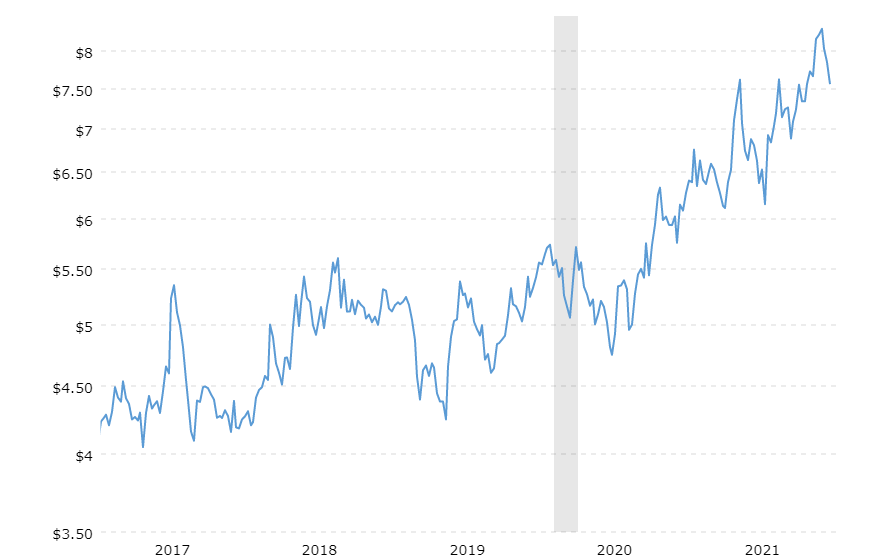
Source: Macrotrends
In fact, according to a 2021 Deloitte report, companies are actively concerned about the impact of climate change issues on their activities, with climate-related disasters topping the list and scarcity of resources a close second.
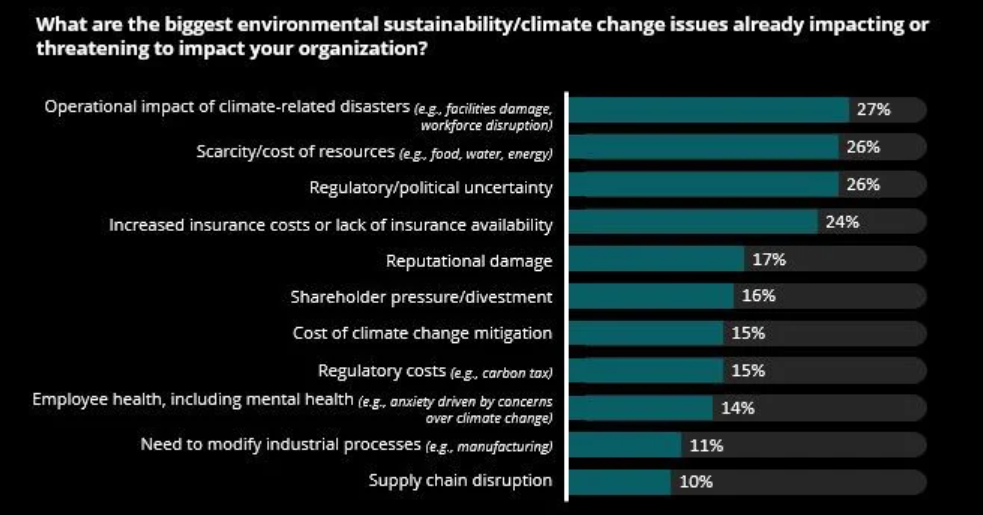
Source: Deloitte
Being prepared for extreme events means, in most cases, managing risks across company facilities, as well as across the value chain. The more widespread and varied the production footprint and sourcing capabilities, the better can a company weather the storm.
Supply chain issues: No end in sight
No, it’s not getting better soon.
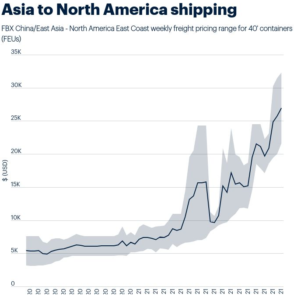
In fact, after over a year of constant disruptions, problems have accumulated into a perfect storm. Unpredictable demand and availability, as well as unpredictable labor shortages, both due to COVID-19 and various side-effects and accidents, have pushed container availability and port unloading infrastructure into a frenzied downward spiral. While container prices have gone up (over $20,000 for a standard container coming to the US from east Asia), ports have been unable to handle the incoming ships’ unloading needs.
Some ports have already moved to 24/7 operations, yet the issues will take much longer to fix – and prices are not likely to come down in a hurry. However, reliable forecasting in such turbulent times is nearly impossible.
In these circumstances, old wisdom can be reactivated. Instead of the cheaper and more agile just-in-time model that many companies practiced, increasing safety stocks and developing a wider global footprint are going to be the norm. On top, developing excellent relations with suppliers and managing customer expectations are critical. As Dan Swan, McKinsey Operations expert, put it: Supply chains are no longer a “necessary evil”, but more and more “a real differentiator for companies”. Product availability is the new name of the game.
In the meantime, expect prices and lead time to remain high for quite a while yet.
Digitalization: Keeping up with the world
To the surprise of no one with any knowledge of markets, a 2019 study by Deloitte confirmed that businesses on their path to digital transformation tend to perform better financially. In the meantime, COVID-19 has accelerated this trend. With the Zoom boom and remote working, digital communications have become the norm – and time is not going back. In 2022, a mature company should also be a digitally mature company.
What does digital maturity mean? By and large, according to Deloitte’s concept of “pivoting to digital maturity”, it means that organizations use data and technology “to continuously evolve all aspects of its business models—what it offers, how it sells (interacts with its customers) and delivers, and how it operates”.
In 2022, organizations will feel even more under pressure to step up: connecting employees across multiple locations, integrating “business technologists” into their organigrams and empowering them to bring digitalization home, agility through autonomous modular processes, automation in every possible quarter, and more.
In some sectors, digitalization is self-implied. ICT, media, finance, and professional services are more digitally advanced than others. Logistics, retail, and other industries that rely on distributed databases will also make progress. However, even in agriculture and animal production, where most outsiders still picture tractors and barns, the fourth revolution is in full progress. The power of data, the possibilities brought by the cloud, the ease of synchronous communication will impact even the most conservative industries. Whoever is not prepared for digitalization will inevitably fall behind.
Human resources: Labor shortages, happynomics and more
How is it possible to have both high employment and labor shortages at the same time?
#2 on the list of concerns for Gen Z, as evidenced in Deloitte’s research, is unemployment. And yet, the evidence is mounting that most companies (nearly 9 in 10, in one study) are having trouble filling certain positions – especially entry- and mid-level.
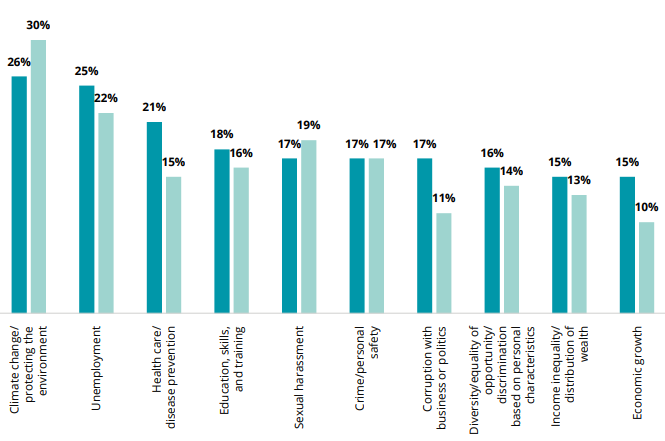
Source: Deloitte
In the US, analysts have been scratching their heads at a disconnect between 8.4 million unemployed and 10 million job openings, with radical differences in sectors such as professional and business services or education and health services.
Most answers focus on the realities of the “Corona times”. People who were forced to work remotely discovered that they enjoyed it. They left inflexible jobs for more flexible ones – or just to spend more time with the family.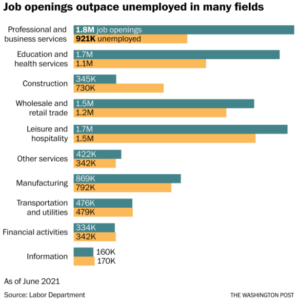
At the same time, childcare insecurity made it compulsory for some parents to give up their jobs to be home for children whose schools or care centers were closed in lockdown.
Workers in retail and hospitality, who saw their jobs being threatened, again and again, by COVID-19. Many were furloughed or sent into unemployment. While out of work, unemployment benefits allowed people to reconsider career paths – and many decided to move to more secure industries.
And, finally, workers whose jobs are not threatened fall prey to burnout during intense work-from-home bouts during long and/or repeated lockdown periods.
If companies have trouble filling positions, they might consider offering more flexibility. Another study by Gartner shows that, at least theoretically, employers and employees are aligned in seeing flexibility as critical to the organization. This includes as a top consideration the ability to work both from home and from the office, as well as somewhat flexible work times.
Yes, work-from-home will outlast COVID-19. At the same time, the concept of happynomics – the economics of personal happiness and well-being – is being transposed at work, with more corporate care for productivity through employee workplace satisfaction. It is by now quite clear that, the happier people are at work, the better the organizational outcomes.
***
Five challenges, each of them compounded by the prolonged uncertainty of COVID-19 and by looming political tensions in various hotspots around the world. Businesses large and small are already critically affected by all. No business will be spared from at least one of the 5 factors; many will be impacted by several or all.
In 2022, companies must be ready to pivot, change strategies, and adjust course mid-route. That doesn’t mean the first step shouldn’t be, always and most critically, planning for these 5 challenges. Dwight Eisenhower was right: Plans are worthless, but planning is everything.
















